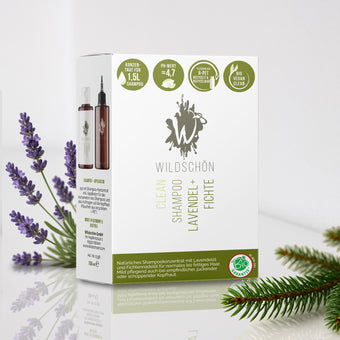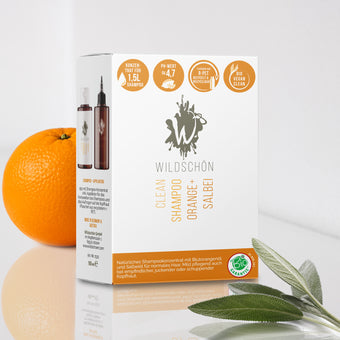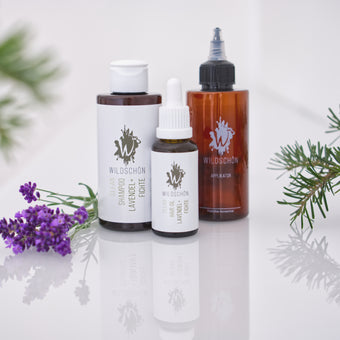About silicones in hair care products - and what alternatives there are
- What are silicones doing in shampoos? (Spoilers: nothing!)
- How to recognize silicones in shampoo.
- Why switching to silicone-free shampoos takes a little patience.
When you think of silicone, is the first thing you think of as sealing joints? You are definitely spot on there. But you can also find silicone in other areas, for example in the kitchen when you grease a cake pan with your silicone brush. You might also use a silicone baking mold (which you then no longer have to grease, of course). You will also find silicone as an approved ingredient in conventional cosmetic products. Whether shampoo, body lotion, face cream, make-up or lipstick – silicone can be found there and in other cosmetics. Of course not in the same form as for the joint seal, the silicone brush or the silicone baking mold.
Slowly and from the beginning: What is silicone anyway?
Don't worry, the chemistry nerd stays in the box! Silicone is not an element of its own, but a combination of silicon and oxygen - both occur naturally on earth. But this is where the naturalness ends. Because silicon and oxygen do not combine by themselves. That only works in the lab. So silicone is an artificial substance – a plastic. Now man-made fabrics are not bad per se. In some areas we have become so used to it that it is difficult to imagine life without it. Such a refrigerator without coolant? Hmm... The question is always: do we absolutely need the plastic or can't we do without it.
What do silicones do in shampoos?
When you use a shampoo, you want a well-groomed and healthy scalp, fantastically beautiful hair that caresses your head in a silky and shiny way. This is exactly where silicones come into play in conventional shampoos. In cosmetic products, silicones are supposed to make skin, hair or lips smooth, supple or easier to comb. Smooth skin, shiny silky hair and a supple, kissable mouth - who can resist you! Sometimes silicones are added to cosmetic products to help other ingredients dissolve better. In most cases, however, it is about the first reason mentioned: Silicones are so-called film formers. As the name suggests, they form a film - also on skin and hair. This evens out small imperfections such as wrinkles or damaged hair surfaces. The surface is smoother and reflects light better than before. The result: the skin appears smoother. Your hair slips through the comb. If you have curls, they fall softer. And fine hair does not fly through the air with an electrostatic charge. Even split ends are sealed. Impressive what silicone can do! Even after the first wash, your hair can feel smooth, shiny and silky. But what is actually smooth and shiny here is the silicone - and not the hair.
Silicone build-up effect instead of being nourished and cared for
Silicones are usually added to cosmetic products as silicone oils. Oil sounds natural at first (petroleum is also a natural oil), and also nourishing or rich. However, this does not apply to silicone oils, because they do not care for hair and skin. However, skin and hair need moisture as well as nutrients and care substances in order to be healthy and look smooth and shiny. In the past, water-insoluble silicones were generally used in conventional cosmetic products. As a result, a real silicone layer has built up around the hair (and also on the scalp) over time - also known as silicone build-up. To prevent this, water-soluble silicones have been developed that are easier to wash off the skin and hair. Regardless of whether it is water-soluble or not, when your hair is wrapped in an extra layer, it logically makes it heavier. This is also the case with silicone. Apart from the fact that not everyone is a fan of the sleek look, this can make your hair greasy faster. On the one hand, because they lie flat on the scalp. On the other hand, because the hair dries out under the silicone layer - and this stimulates the body's own sebum production.
From hair to groundwater: sustainability of silicones
Apart from the fact that a lot of carbon dioxide is produced and crude oil is consumed during the production of silicone, disposal is also problematic. It doesn't matter whether it's water-soluble or non-water-soluble silicone. Water-soluble silicones stick less to skin and hair. So they flow down the drain when you shower. And because your hair isn't "silicone magnets," even with non-water-soluble silicones, some of it ends up in the shower drain. Even if the sewage treatment plants are getting better and better, silicones can neither be broken down nor completely filtered out. A remainder simply remains in the water. In addition, parts of the sewage sludge are also used to make fertilizer. Even the silicones filtered out are not safe and can get into the water cycle via the fertilizer. You then meet them again in lakes or rivers. Or in the groundwater.
Does a product contain silicone? INCI provides information.
Deciding on a product is sometimes quite difficult due to the huge selection. How are you supposed to find one that doesn't contain silicones? Some manufacturers make it easy for you and simply write "without silicone" on their product. Never seen? That could be because an estimated 90 percent of shampoos contain some form of silicone. As with other things, it's worth taking a look at the small print, here: the ingredients. As with foodstuffs, manufacturers are obliged to declare them if they exceed a certain quantity or belong to a certain category, e.g. B. can trigger allergic reactions. Sometimes the ingredients are also hidden behind the designation "Ingredients" or "INCI". You can often find them on the back of the product or on the packaging. Sometimes even more hidden under a peel-off label for very small or packaging-free products such as lipsticks. By the way, the further up an ingredient is in the list, the more of it there is.
Many different names for silicones
If you look at the ingredient lists of a few products, you'll probably notice that there is no mention of silicones or silicone oil. Even if silicones have always been mentioned here, this is only a rough category, something like "shampoo". There isn't just one type of it either. So there are also many different silicones, depending on what else is added during production. It is therefore not enough to simply write "silicone" or "silicone oil" in the list of ingredients - it must be the exact name. This could e.g. B. be important for allergy sufferers, as well as with food. Dimethicone, Methicone, Polysiloxane, and Cyclomethicone are some silicones that you'll find fairly common when looking at the content list. And even of those there are still a few "family members". Did you notice that the examples all end in "-cone" or "-xan(e)"? Exactly by these endings you can recognize many silicones relatively easily.
Are there also hair care products without silicone?
In a nutshell: Yes! You may have spotted them here and there on the shelves while shopping: products labeled “without silicone”. With these, your hair will not look strawy and dull, nor will your comb get stuck in it. Nobody wants that either, so what do the manufacturers put in instead? There are two options here: the first one costs less and is artificial. Because silicone is not a unicorn, other artificial film formers are simply used (e.g. polyethylene or acrylates). They also form a film around your hair, making it smooth, shiny and easy to comb. This is not due to a silicone layer, but to another plastic layer. For the environment, it is therefore also jumped as jumped whether silicone or other film-forming plastics are floating in the water: the silicone substitute plastics are just as little degradable and cannot be completely filtered out as silicone itself. The second option is more complex and natural: we are talking about vegetable oils and your skin's ability to self-regulate your hair health through the production of sebum - i.e. sebum. And because these oils are natural, they can biodegrade and, in the usual amounts found in shampoo, are not a problem down the drain.
Switching to natural shampoo requires some patience.
There is indeed a challenge - and you will master it! All you need is a little bit of patience. And if you've read this far, then you've got it ;-) First of all: If you're getting married soon or have another very important appointment, you might be better off changing afterwards. The reason for this is relatively simple: If you have previously used a shampoo containing silicone, then your hair will be coated in silicone. Once you've rid your hair of it, wash after wash, it will take a while before it's shiny and silky again. After all, they've had a long dry spell and need to be nursed back to health. It may also be the case that your hair is greasy or straw-like more quickly at first. After all, your body also has to adapt and regulate sebum production. Incidentally, sebum is the body's own fat that is supposed to prevent the skin and hair from drying out. This is where your patience is required. Because then it is your hair that shines silky and not a layer of silicone (or other synthetics). Even if the advertising wants to sell it differently: Your hair is naturally beautiful. If you brush them properly and care for them naturally, they can fully develop. Sometimes plastic is practical, but superfluous - what nature has to offer is enough.









